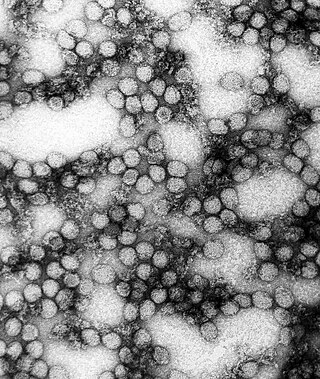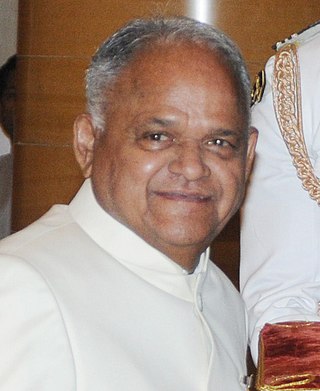Related Research Articles

The University of California, Riverside is a public land-grant research university in Riverside, California. It is one of the ten campuses of the University of California system. The main campus sits on 1,900 acres (769 ha) in a suburban district of Riverside with a branch campus of 20 acres (8 ha) in Palm Desert. In 1907, the predecessor to UCR was founded as the UC Citrus Experiment Station, Riverside which pioneered research in biological pest control and the use of growth regulators.

Flavivirus, renamed Orthoflavivirus in 2023, is a genus of positive-strand RNA viruses in the family Flaviviridae. The genus includes the West Nile virus, dengue virus, tick-borne encephalitis virus, yellow fever virus, Zika virus and several other viruses which may cause encephalitis, as well as insect-specific flaviviruses (ISFs) such as cell fusing agent virus (CFAV), Palm Creek virus (PCV), and Parramatta River virus (PaRV). While dual-host flaviviruses can infect vertebrates as well as arthropods, insect-specific flaviviruses are restricted to their competent arthropods. The means by which flaviviruses establish persistent infection in their competent vectors and cause disease in humans depends upon several virus-host interactions, including the intricate interplay between flavivirus-encoded immune antagonists and the host antiviral innate immune effector molecules.

Aedes aegypti, the yellow fever mosquito, is a mosquito that can spread dengue fever, chikungunya, Zika fever, Mayaro and yellow fever viruses, and other disease agents. The mosquito can be recognized by black and white markings on its legs and a marking in the form of a lyre on the upper surface of its thorax. This mosquito originated in Africa, but is now found in tropical, subtropical and temperate regions throughout the world.
The history of the University of California, Riverside, or UCR, started in 1907 when UCR was the University's Citrus Experiment Station. By the 1950s, the University had established a teaching-focused liberal arts curriculum at the site, in the spirit of a small liberal arts college, but California's rapidly growing population made it necessary for the Riverside campus to become a full-fledged general campus of the UC system, and it was so designated in 1959.
The 2006 dengue outbreak in Pakistan was at the time the worst on record. There were 1931 lab-confirmed cases, and 41 confirmed deaths, according to the World Health Organization Regional Office for the Eastern Mediterranean. Other sources report a death toll of 52.

In entomology, anautogeny is a reproductive strategy in which an adult female insect must eat a particular sort of meal before laying eggs in order for her eggs to mature. This behavior is most common among dipteran insects, such as mosquitoes. Anautogenous animals often serve as vectors for infectious disease in their hosts because of their contact with hosts' blood. The opposite trait is known as autogeny.

The discipline of medical entomology, or public health entomology, and also veterinary entomology is focused upon insects and arthropods that impact human health. Veterinary entomology is included in this category, because many animal diseases can "jump species" and become a human health threat, for example, bovine encephalitis. Medical entomology also includes scientific research on the behavior, ecology, and epidemiology of arthropod disease vectors, and involves a tremendous outreach to the public, including local and state officials and other stake holders in the interest of public safety.
Eva Harris is a professor in the School of Public Health at the University of California, Berkeley, and the founder and president of the Sustainable Sciences Institute. She focuses her research efforts on combating diseases that primarily afflict people in developing nations.
Andrew Spielman was a prominent American public health entomologist and Professor of Tropical Public Health in the Department of Immunology and Infectious Disease at the Harvard School of Public Health (HSPH).
The University of California Citrus Experiment Station is the founding unit of the University of California, Riverside campus in Riverside, California, United States. The station contributed greatly to the cultivation of the orange and the overall agriculture industry in California. Established February 14, 1907, the station celebrated its 100th anniversary in 2007.
Entomological warfare (EW) is a type of biological warfare that uses insects to interrupt supply lines by damaging crops, or to directly harm enemy combatants and civilian populations. There have been several programs which have attempted to institute this methodology; however, there has been limited application of entomological warfare against military or civilian targets, Japan being the only state known to have verifiably implemented the method against another state, namely the Chinese during World War II. However, EW was used more widely in antiquity, in order to repel sieges or cause economic harm to states. Research into EW was conducted during both World War II and the Cold War by numerous states such as the Soviet Union, United States, Germany and Canada. There have also been suggestions that it could be implemented by non-state actors in a form of bioterrorism. Under the Biological and Toxic Weapons Convention of 1972, use of insects to administer agents or toxins for hostile purposes is deemed to be against international law.

Mosquito-borne diseases or mosquito-borne illnesses are diseases caused by bacteria, viruses or parasites transmitted by mosquitoes. Nearly 700 million people contract mosquito-borne illnesses each year, resulting in more than a million deaths.

Vinod Prakash Sharma was an Indian malariologist and entomologist, known for his work in vector biology and bioenvironmental control of malaria. Recipient of many awards, including the Padma Shri, he was again honoured by the Government of India, in 2014, by bestowing on him the third highest civilian award, the Padma Bhushan.
Jacinta Duncan is an Australian science educator who grew up on marginal farming land in the Millewa area in the top North West of Victoria. Working alongside her father, Duncan learned animal husbandry, and how to crop wheat and barley while her mother, a primary school teacher, taught her music, French and took her to learn ballet. Duncan says "the importance of an inquisitive mind and a robust education has always been at the forefront of my life".

Natasha V. Raikhel is a professor of plant cell biology at University of California, Riverside and a member of the National Academy of Sciences.
Xuemei Chen is a Chinese-American molecular biologist. She is the Furuta Chair Professor in the Department of Botany and Plant Sciences at the University of California, Riverside. She was elected to the US National Academy of Sciences in 2013.
Seymour Dean Van Gundy was an American professor emeritus of nematology at University of California, Riverside and former dean of the College of Agriculture and Natural Resources.
Mariana Federica Wolfner is the Goldwin Smith Professor of molecular biology and genetics at Cornell University. Her research investigates sexual conflict in the fruit fly Drosophila melanogaster. She was elected a member of the National Academy of Sciences (NAS) in 2019 in recognition of her distinguished and continuing achievements in original research.

Global climate change has increased the occurrence of some infectious diseases. Infectious diseases whose transmission is impacted by climate change include, for example, vector-borne diseases like dengue fever, malaria, tick-borne diseases, leishmaniasis, zika fever, chikungunya and Ebola. One mechanism contributing to increased disease transmission is that climate change is altering the geographic range and seasonality of the insects that can carry the diseases. Scientists stated a clear observation in 2022: "The occurrence of climate-related food-borne and waterborne diseases has increased ."
Thomas Wallace Scott is an American tropical infectious disease epidemiologist.
References
- 1 2 3 "Alexander Raikhel". University of California, Riverside . Archived from the original on March 11, 2015. Retrieved 2015-03-03.
- ↑ "Alexander S. Raikhel". National Academy of Sciences . Retrieved 2015-03-11.
- 1 2 3 4 5 6 7 Davis, Tinsley H. (December 28, 2010). "Profile of Alexander S. Raikhel". Proceedings of the National Academy of Sciences . 107 (52): 22381–22383. Bibcode:2010PNAS..10722381D. doi: 10.1073/pnas.1018340108 . PMC 3012477 . PMID 21173217.
- 1 2 3 4 5 6 Pittalwala, Iqbal (April 28, 2009). "UC Riverside Professor Receives Top Scientific Honor".
- 1 2 "Alexander S. Raikhel, ESA Fellow (2009)". Entomological Society of America . August 2009.
- ↑ Weeks, Eric; D'Antonio, Michael (May 2001). "Making a New Mosquito Will tinkering make mosquitoes better or worse?". Discover .
- ↑ Keckeisen, Kevin (May 15, 2012). "Mosquito population bit by birth control". UCR Highlander.
- ↑ "Researchers Discover Natural Insect Growth Regulators in Plants". Entomology Today . January 28, 2015.
- ↑ "Discovery by UC Riverside Entomologists Could Shrink Dengue-spreading Mosquito Population". sciencenewsline.com. December 2, 2010. Archived from the original on April 2, 2015. Retrieved March 11, 2015.